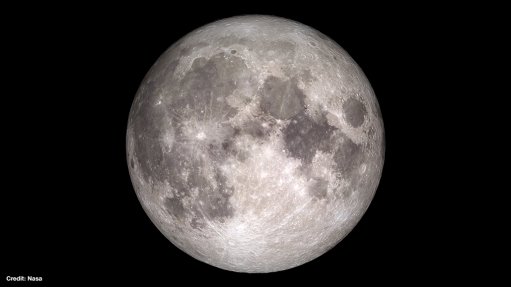
Photo by: Nasa
Scientists using data from the US National Aeronautics and Space Administration’s (Nasa’s) Lunar Reconnaissance Orbiter (LRO) spacecraft have discovered evidence that the Moon might, underneath its surface, be richer in metals (such as iron and titanium) than had previously been believed. Nasa is the American space agency and the scientists were members of the Miniature Radio Frequency (Mini-RF) experiment team. The Mini-RF instrument is one of the experiments carried on the LRO.
The evidence was discovered while the researchers were looking for ice at the bottom of craters in the lunar north pole region. The discovery will affect the theories about the Moon’s formation. “The LRO mission and its radar [Mini-RF] instrument continue to surprise us with new insights about the origins and complexity of our nearest neighbour,” enthused Johns Hopkins University Applied Physics Laboratory (APL) Mini-RF principal investigator Wes Patterson. (The Mini-RF was designed and built by an research institute/industry team led by APL.)
It is currently believed (a belief backed by a lot of evidence) that the Moon was formed as the result of a collision between the young Earth and a protoplanet the size of Mars. As a result, the Moon has a bulk chemical composition very similar to that of Earth. But there are oddities. The lunar highlands – visible as bright plains on the Moon’s surface – are composed of rocks which are poorer in metal-containing minerals relative to Earth rocks. But the Moon’s famous maria (‘seas’) – the dark plains – comprise rocks richer in metals-bearing minerals than many rocks on earth.
These facts have long been a puzzle, but the Mini-RF data could result in an explanation. The research team was using the instrument to measure a phenomenon called the dielectric constant in the lunar ‘soil’ (regolith) that is piled on the floors of craters. “[T]he dielectric constant [is] a number that compares the relative abilities of a material and the vacuum of space to transmit electric fields” explained Nasa.
What the team discovered was that the dielectric constant increased with increasing crater size, in craters measuring from about 2 km to 5 km in diameter. With craters 5 km to 20 km in diameter, the dielectric constant stayed, for want of a better word, constant. “It was a surprising relationship that we had no reason to believe would exist,” said Mini-RF experiment co-investigator Essam Heggy.
Dielectric properties are directly linked to concentrations of iron and titanium oxides. Larger craters are caused by meteors that dig deeper into the lunar surface. So the researchers are hypothesising that these meteors, when they hit, excavated these metal oxides from beneath the Moon’s surface.
The team then compared the radar images of the crater floors from the Mini-RF with metal oxide maps developed using the LRO’s Wide-Angle Camera, Japan’s Kaguya lunar orbiter and Nasa’s Lunar Prospector spacecraft. This established that the larger craters, with their greater dielectric material, were indeed richer in metals. This suggests that the lunar subsurface from 0.5 km to 2 km in depth is richer in iron and titanium oxides that the top subsurface layer (from 0.2 km to 0.5 km in depth).
The research team is now examining crater floors in the Moon’s southern hemisphere, to see if they produce similar results. “It really raises the question of what this means for our previous formation hypotheses,” pointed out Heggy. The discovery reduces uncertainty regarding the distribution of iron and titanium oxides below the lunar surface and provides important information for the improvement of the theories about the Moon’s formation.